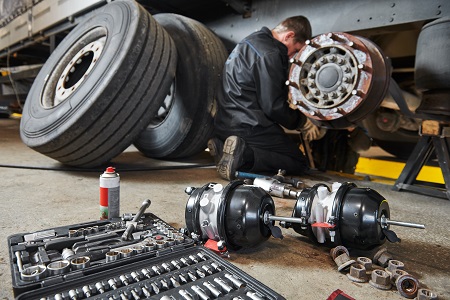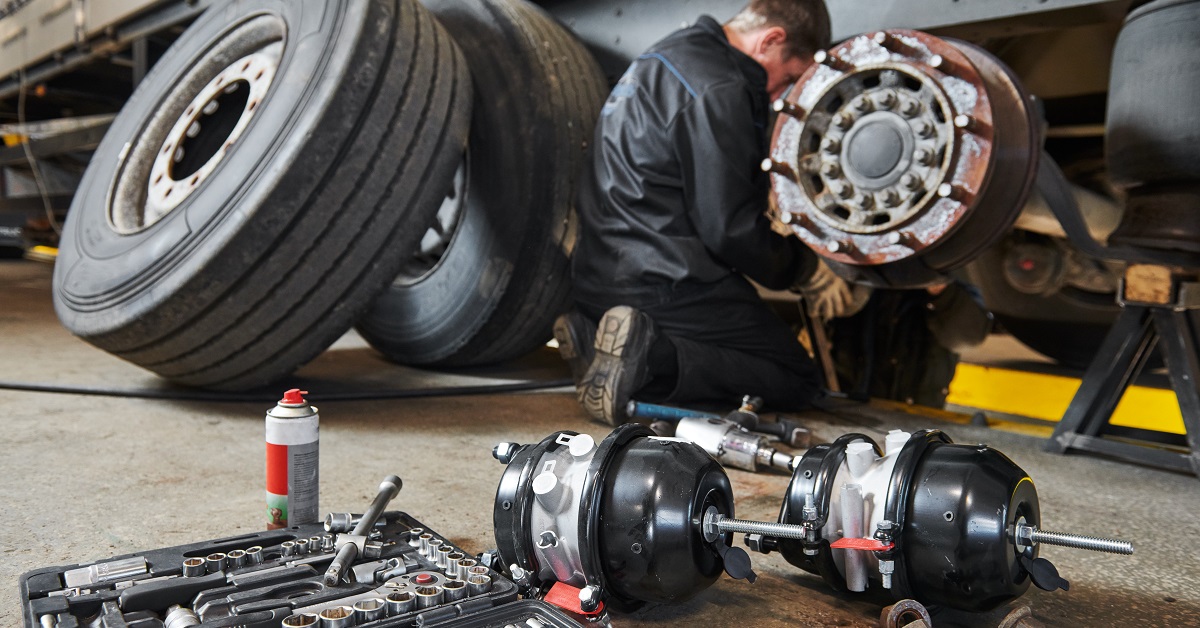The most important security feature of any semi truck is the brakes. They do not just stop your vehicle, they help control its momentum and trajectory. This is why when brakes start to wear out, they will need repair, replacement or maintenance as quickly as possible so that you can keep driving safely and avoid any accidents. Because the air braking systems on modern semi trucks consists of two sections, a supply system and a control system, there can be a lot to remember.
Ed’s 24 Hour Service is here to explain the signs on both sections that indicate when your brakes need to be replaced on your semi truck. Additionally, because of the rapid adoption of disk and air brake systems, we’re not going to focus on antiquated system of the brake drum and shoe. Let’s get started!
You Hear Loud Screeching and Squealing Noises When Engaging the Brakes


Loud noises coming from the wheels implies a problem with the components inside the actual wheel. If an unusual amount of heat accompanies a loud screech from the brake rotors, there is likely a problem with the brake pads. It’s a little difficult to see if the brake pads are worn from outside of the wheel and usually requires removing the hubcap if not the entire wheel in order to attain a more thorough picture. The general rule of thumb for semi truck brake pad replacement runs every 30,000 miles.
It is recommended however to perform frequent and routine maintenance checks for other brake system components that need attention such as compressed air PSI or a particularly over tuned caliper or a worn rotor. While replacing brake pads and compressed air might be easy, repairing the calipers or replacing a rotor might require more studied hands at an automotive repair shop.
The Brake Pedal Either Sinks Down Too Far or Has No Resistance in it at All
If you thought there was already plenty components on the wheel side of the braking system, prepare to be inundated with even more components inside of the engine bay. Inside the engine bay, the braking system comprises of a supply system and a control system. Should you find yourself having to really push down on the brakes before the actual mechanism engages and begins to dictate the speed of the vehicle, something in these two systems may need a tune up.
A faulty brake pedal itself pretty self explanatory–but if the pedal is in the good condition and still has no resistance or too much resistance then one of three components could be malfunctioning. Either the compressed air reservoir is empty, the air compressor is not working or the air dryers are allowing moisture to build up in your brake lining. When one of these components fail, it will take far more braking power than human to actually engage the brakes.
There are Air Leaks Coming from the Brakes
You will want to make sure there are no compressed air leaks coming from the engine bay and the wheels. You will know when your air pressure is too low when the red wig-wag pops up near the reservoir. While an air brake hose can actually run while leaking a bit of compressed air, it will require more foot pressure to engage. The brakes may not feel like they are “quitting” on you but if it’s hard for them to cope–or worse yet, if they start dragging–your air brake functionality is compromised.
Compressed air is the glue that makes all of the moving parts in an air braking system stick together. Without it, moisture and uncompressed air will fill the air hoses. Compared to standard hydraulic brake fluid or compressed air, uncompressed air will fill whatever container as much as possible just fine. It will expand and contract with little push back, if not outright escaping through the same exits. Your brakes will start to work less and less until they collapse to the floor with little to no resistance and no braking power and what happens next is largely dependent on how lucky you are.
Risks of Driving With a Faulty Brake Line


Do not drive any vehicle that is leaking hydraulic fluid or too low on compressed air–once the car starts moving, your chances of stopping are rapidly diminished. A commercial truck in particular will transform from a controlled automobile to an unstoppable juggernaut. Whatever you hit will most likely be destroyed. Other internal systems of the vehicle can also be ruined. When you finally stop, you should immediately begin accident and collision procedures and inquire into a new change of pants.
The risk-reward of driving with possible brake failure just isn’t worth it from any monetary, legal or mental standpoint. The nightmare scenarios are too vast and too many. Choosing to have the vehicle transported by a local towing company and mended at the nearest automotive repair shop presents a far more safe and economical choice.
Ed’s 24 Hour Service Provides Towing and Roadside Assistance Services
Given the stakes, it makes sense to take your semi truck’s brakes seriously. We outlined a few things you can do to make sure they are in tip-top shape before, during and after every job. Firstly, always check for loud screeching or squealing noises from the brake pads when braking sharply; secondly, never let your discs or pads get so worn that there is no resistance on the pedal; finally, inspect all of your brake fluid lines for any leaks. If your brakes need maintenance or repair near Marion County, Ohio, Ed’s 24 Hour Service is here to help. From roadside assistance to heavy-duty towing to semi truck repair services at our very own automotive repair shop, Ed’s has got you covered! Contact us today to find out more.

